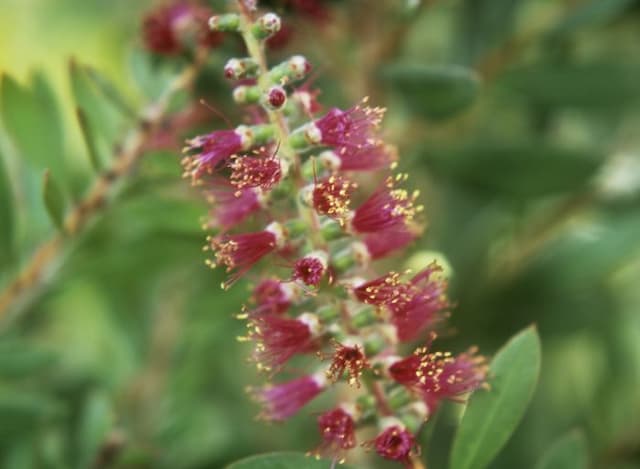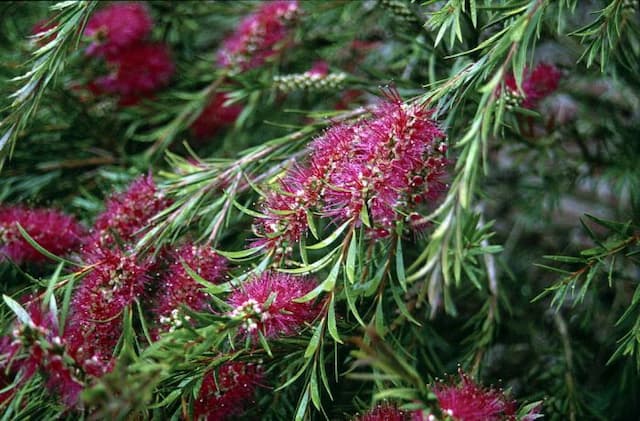Lemon Bottlebrush Callistemon pallidus

ABOUT
Callistemon pallidus, commonly known as Lemon Bottlebrush, is a striking plant primarily recognized for its distinctive flower spikes that resemble bottle brushes. These elongated and cylindrical flowers boast a pale yellow to creamy coloration, which comes from the numerous protruding stamens that offer an eye-catching contrast against the foliage. The leaves of the Lemon Bottlebrush present a light green hue and typically have a narrow, lance-shaped appearance. They are slightly leathery in texture, with a firm and somewhat waxy surface, contributing to the overall hardiness of the plant. Furthermore, the leaves often exude a citrusy fragrance when crushed, enhancing the sensory experience of this plant. With its delicate blossoms and aromatic leaves, the Lemon Bottlebrush is appreciated not only for its beauty but also for its ability to attract pollinators such as birds and bees, adding a lively dynamic to its surroundings. The Lemon Bottlebrush makes a lovely addition to a variety of garden settings, offering a splash of soft color and textural interest.
About this plant
 Names
NamesFamily
Myrtaceae
Synonyms
Lemon Bottlebrush, Pale Bottlebrush
Common names
Melaleuca pallida, Metrosideros pallida, Callistemon brachyandrus.
 Toxicity
ToxicityTo humans
The plant known as Lemon Bottlebrush (Callistemon pallidus) is generally not considered toxic to humans. There is a lack of significant evidence to suggest that this plant causes poisoning upon ingestion. However, as with many plants, individual allergies may exist, and it is always advisable to avoid ingesting parts of ornamental plants due to potential individual reactions or the presence of unknown substances.
To pets
The Lemon Bottlebrush (Callistemon pallidus) is also generally not considered toxic to pets. There is no widely documented evidence that this plant causes poisoning in pets when ingested. However, it's important to monitor pets around plants, as individual animals may have different sensitivities or reactions to plant material, and ingestion of non-food items can sometimes lead to gastrointestinal upset. If a pet shows signs of distress after ingesting plant material, consult a veterinarian.
 Characteristics
CharacteristicsLife cycle
Perennials
Foliage type
Evergreen
Color of leaves
Green
Flower color
Yellow
Height
6-10 feet (1.8-3 meters)
Spread
6-10 feet (1.8-3 meters)
Plant type
Shrub
Hardiness zones
8
Native area
Australia
Benefits
 General Benefits
General Benefits- Attracts Wildlife: Callistemon pallidus, commonly known as Lemon Bottlebrush, provides nectar for pollinators like bees and is also attractive to birds, particularly nectar-feeding species.
- Drought Tolerance: Once established, Lemon Bottlebrush is drought-resistant, making it suitable for xeriscaping and for gardeners seeking low-water-use plants.
- Erosion Control: The plant's root system helps to stabilize soil, preventing erosion on slopes and banks.
- Ornamental Value: With its bright yellow flowers and evergreen foliage, Lemon Bottlebrush adds year-round aesthetic appeal to gardens and landscapes.
- Low Maintenance: It requires minimal care once established, making it an excellent choice for gardeners of all skill levels.
- Habitat Restoration: It can be used in native planting schemes to help restore natural habitats and ecosystems.
- Windbreak: The dense foliage can serve as a windbreak, providing shelter from strong winds in exposed areas.
- Privacy Screen: When planted in rows or hedges, Lemon Bottlebrush can create a natural privacy screen for homes and gardens.
 Medical Properties
Medical PropertiesThis plant is not used for medical purposes.
 Air-purifying Qualities
Air-purifying QualitiesThis plant is not specifically known for air purifying qualities.
 Other Uses
Other Uses- Leaves as a natural dye: The leaves of the Lemon Bottlebrush can be used in the production of a natural green dye for fabrics and wool.
- Educational use: Due to its unique brush-like flowers, the Lemon Bottlebrush can be an example in botanical studies to showcase plant adaptations and pollination strategies.
- Garden aesthetic and design: Its bright yellow flowers and contrasting green foliage are used in landscaping for color balance and visual interest.
- Erosion control: The Lemon Bottlebrush's root system can help stabilize the soil and prevent erosion on slopes and riverbanks.
- Craft material: Dried flowers can be used in floral arrangements or as potpourri for crafts and decoration.
- Habitat support: The dense foliage can provide shelter and nesting sites for birds, small mammals, and insects.
- Perfumery: The aromatic oils in Lemon Bottlebrush flowers and leaves could be used in creating natural fragrances or essential oils.
- Privacy screening: When planted in rows or hedges, the Lemon Bottlebrush can act as a natural privacy screen for gardens and outdoor spaces.
- Photography subject: The striking appearance of the Lemon Bottlebrush makes it a popular subject for botanical photography and art.
- Noise reduction: With its thick foliage, the plant can be used as a buffer to reduce noise pollution in urban gardens.
Interesting Facts
 Feng Shui
Feng ShuiThe Lemon Bottlebrush is not used in Feng Shui practice.
 Zodiac Sign Compitability
Zodiac Sign CompitabilityThe Lemon Bottlebrush is not used in astrology practice.
 Plant Symbolism
Plant Symbolism- Resilience: The Lemon Bottlebrush, like other Callistemon species, is known for its tough nature and ability to withstand harsh conditions, symbolizing the capacity to endure difficulties.
- Cleansing: With its brush-like flowers reminiscent of cleaning brushes, the Lemon Bottlebrush signifies purification and the sweeping away of negativity.
- Attraction: The bright flowers of the Lemon Bottlebrush are attractive to birds and bees, symbolizing allure and the ability to draw in positivity and interest.
- Vibrancy: The vivid color of its flowers represents liveliness and energy, suggesting a vibrant and enthusiastic approach to life.
- Renewal: As an evergreen plant that constantly renews its foliage, the Lemon Bottlebrush embodies the idea of continual growth and renewal.
 Water
WaterThe Lemon Bottlebrush, commonly known as the Callistemon pallidus, should be watered deeply to encourage a strong root system, particularly during its first growing season. After establishment, it's fairly drought-resistant and needs less frequent watering. For mature plants, watering once every two to three weeks in dry periods should suffice. Apply approximately 1-2 gallons of water per watering session, ensuring that the soil is moist but not waterlogged. During winter or in cooler climates, reduce the watering frequency as the plant requires less moisture.
 Light
LightLemon Bottlebrush thrives best in full sunlight, meaning at least 6 to 8 hours of direct, unfiltered sunlight each day. Place it in a location where it won't be shaded by larger plants or buildings to ensure it gets ample light. Partial shade is acceptable, but the plant may not flower as prolifically in reduced lighting conditions.
 Temperature
TemperatureThe Lemon Bottlebrush is hardy and can tolerate a range of temperatures, but prefers mild to warm climates. It can survive minimum temperatures down to around 20 degrees Fahrenheit but thrives best between 50 and 90 degrees Fahrenheit. Prolonged exposure to temperatures below freezing may damage the plant, so it should be protected or brought indoors in regions where extreme cold is common.
 Pruning
PruningPruning the Lemon Bottlebrush is necessary to maintain its shape, encourage bushier growth, and enhance flowering. Prune immediately after flowering to prevent cutting off next season's buds. Typically, it's sufficient to prune once a year, but if the plant is growing vigorously or you wish to maintain a specific shape, you might prune lightly a second time in late summer. Remove any dead or diseased branches to keep the plant healthy.
 Cleaning
CleaningAs needed
 Soil
SoilLemon Bottlebrush (Callistemon pallidus) prefers well-draining soil with a slightly acidic to neutral pH between 6.5 and 7.0. A mix of loamy soil enriched with organic matter like compost or well-rotted manure will support healthy growth. Regular mulching can help maintain soil moisture and provide essential nutrients.
 Repotting
RepottingLemon Bottlebrush should be repotted every 2-3 years or when rootbound. Young plants may require more frequent repotting, while established plants can be refreshed with new soil in the existing container if they have enough space.
 Humidity & Misting
Humidity & MistingLemon Bottlebrush thrives in moderate to high humidity levels. While it can tolerate lower humidity, maintaining a humidity level of around 50-60% is ideal for this plant.
 Suitable locations
Suitable locationsIndoor
Place in bright, indirect light; water when topsoil is dry.
Outdoor
Full sun, protect from frost, well-draining soil.
Hardiness zone
8-11 USDA
 Life cycle
Life cycleLemon bottlebrush (Callistemon pallidus) begins its life cycle with seed germination, which typically occurs following exposure to moisture and warm temperatures. Seedlings grow establishing a root system and foliage, progressing into juvenile plants. As the plant matures, it enters the vegetative stage where the focus is on leaf and stem growth. Once mature enough, Lemon bottlebrush enters the reproductive phase, characterized by the development of distinctive bottlebrush-shaped inflorescences composed of numerous small flowers, often attracting pollinators. After pollination, flowers develop into woody capsules containing numerous seeds which can persist on the plant for years until they are released following a trigger such as fire. The plant continues to grow and repeat the flowering and seeding cycle annually, living for many years as a perennial shrub.
 Propogation
PropogationPropogation time
Spring to Summer
The Lemon Bottlebrush, scientifically known as Callistemon pallidus, is commonly propagated by semi-hardwood cuttings. This is typically done during the warmer months, from late spring to early summer, when the plant's growth is most active. To propagate by cuttings, a gardener would select a healthy, non-flowering stem of about 4 to 6 inches (10 to 15 centimeters) long. Leaves on the lower half of the cutting are removed, and the cut end is often dipped in a rooting hormone to improve the chances of successful root development. The prepared cutting is then placed in a pot filled with a well-draining propagation mix, ensuring that the nodes where the leaves were removed are buried. The pot is kept moist and in a warm, sheltered location out of direct sunlight until roots have formed, which can take several weeks. After rooting, the new Lemon Bottlebrush plants can be gradually acclimatized to outdoor conditions and then planted in their permanent locations.









